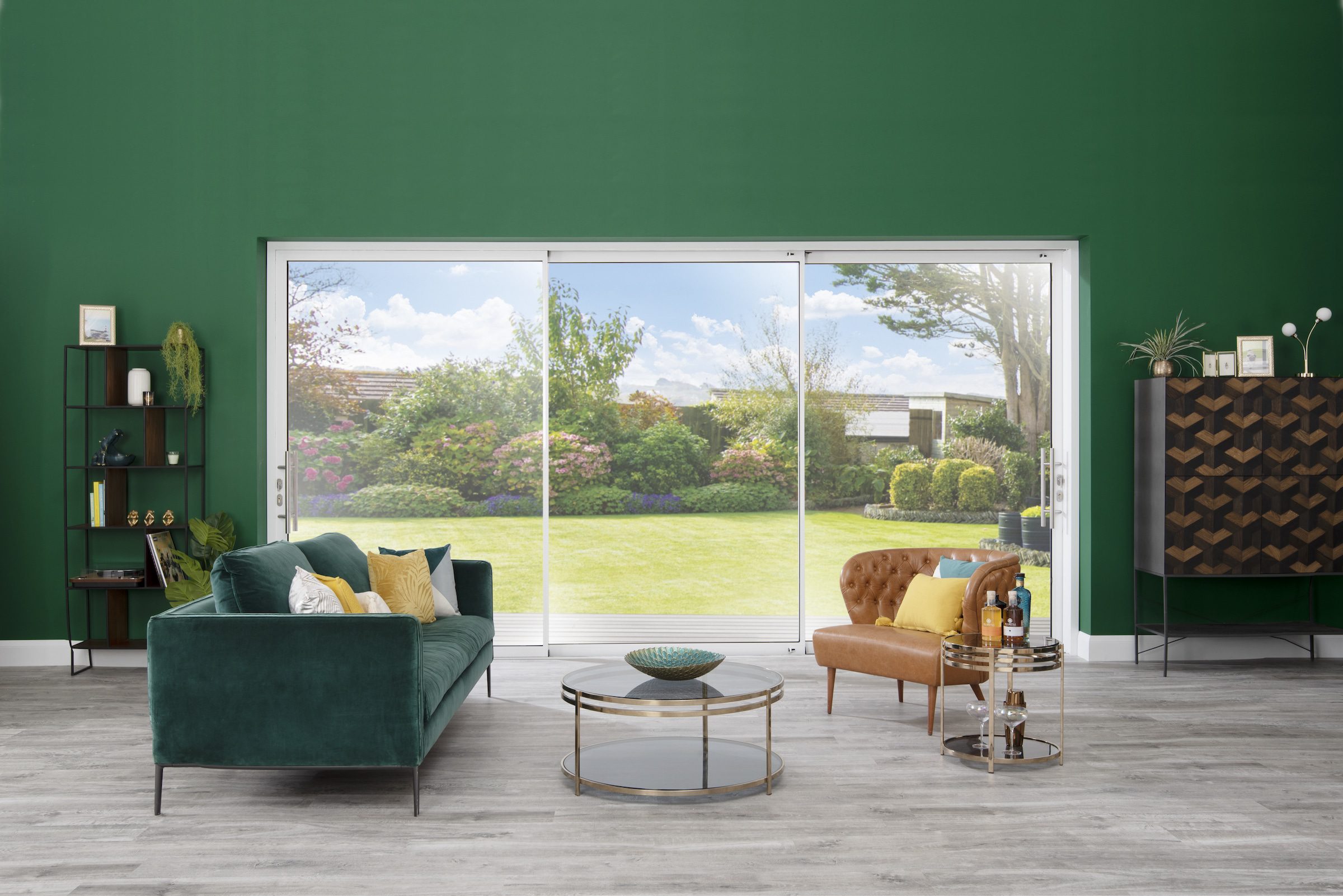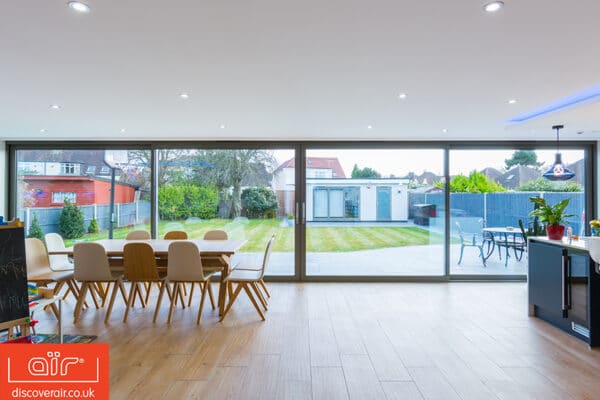Launched in April 2021, the Origin OS-29 sliding door is an even slimmer model in the Origin range of sliding doors. This review gives more information about this modification to their existing OS-44 and OS-77 product.
Origin OS-29 sliding door

With the legendary Origin manufacturing quality and service, Origin OS-29 is an great door for those wanting a slimmer central mullion, but there are potentially better doors for a similar or lower price.
4
Pros
- Origin overall product quality
- Nationwide availability
- Excellent quality door handles
- Suites with other Origin products
Cons
- Only meets Building Regulations Triple Glazed!
- Not as slim as is marketed
- Four-panel middle doors can flex
- Could slide smoother
What is the new Origin OS-29 sliding door

The OS-29 isn’t a brand new sliding door. Instead, this slimmer mullion option provides a solution for those put off by the price and complexity of structurally bonded doors, typically with a 20-24mm mullion.
Joining the existing range of inline sliding doors OS-44 and OS-77, the Origin OS-29 sliding door uses the same design and technology. The only significant difference is the reduction in the middle mullion on patio doors with a two or three panel configuration. All other frame details and dimensions remain exactly the same. If you’re replacing an older set of patio doors, the OS-77 give similar lines to your outgoing doors, in particular the Monarch Monaframe products, PB Systems, Everest, Anglian and similar aluminium sliders from the 1990s to around the mid-2000s. The OS-44 also meets these requirements.
Origin OS-29 comes with an inline sliding operation only – that means the doors sliding on their track in the push pull action.
Read more about the differences between this method of sliding and the modern advanced lift and slide.
Additionally you get highly insulated aluminium profiles, a standard double or triple track arrangement and the choice of double or triple glazing. Anyone familiar with the existing Origin sliding doors range is getting the same door.
Is the Origin sliding door any good?
Suitable for new build or replacement sliding door installations, the Origin OS-29 sliding door comes as two, three or four panel sliding doors .
The overall build quality, fit and finish is fantastic, and to be expected with any product made by Origin, one of the UK’s best known brands. A significant advantage of choosing the Origin brand is getting one brand from one factory with the same all round quality. It’s often the case that buyers prefer windows from one brand, doors from another, front doors from yet another. Origin products go a long way to providing what are generally excellent products for a complete property renovation or building project. Like any door, make and fit it correctly and you’ll get long-term reliability.
By far, the introduction of the OS-29 gives Origin an important product within their range. Not only does it complement their OS-20 Artisan model-based using Cortizo, it also creates a number of solutions for end-user customers and the trade.
- A solution for those wanting the Origin brand in a more slimline style
- A sliding door without the cost and complexity of structurally bonded versions
- A product where guarantee and overall product reputation matter
- Those liking the existing product proposition but wanting thinner mullions
Most important is the confusion around how these sliding doors meet Part L of the Building Regulations. Be aware that this door only complies as a triple-glazed product. It’s the same for the OS-44 and OS-77. A reputable installer should know this and tell you. Many won’t. However, Origin provides this information to all its dealers. Only a triple-glazed door meets Building Regulations.
How much does an Origin OS-29 sliding door cost?
It depends. How much you pay for an Origin sliding door is down to a number of factors such as size, colour, glass specification and the Origin dealer supplying it. There’s no RRP on these products.
Approximate prices excluding VAT for Origin sliding doors, supplied and installed in a black or grey finish are:
OS-29 two-panel 1800x2200mm £4100
OS-29 three-panel 3000x2200mm £5800
OS-29 four-panel 4200x2200mm £7500
Comparing the 29mm mullion sightlines with other sliding doors
Several sliding door brands on the market make claims about the slim nature of their doors. Context is everything with claims about sightlines. The Origin OS-29 sliding door is in no way one of the slimmest in the context of overall sightlines, but it is thin at the door mullion. Many brands are slimmer both in terms of mullion sightlines, overall frame depth, head, track and side jamb face dimensions.
Most if not all of the marketing messages around slimness relate to the door mullions. As a semi-dry glazed system, the OS-29 is certainly amongst the slimmer mullion doors, at 29mm. However, also using the same bonding method at the mullion, there are slimmer doors. Here are just three:
- Sunflex SVG20 with a 20mm mullion
- Edge 2.0 by ID Systems also with a 20mm mullion
- Vision sliding doors provided by YES Glazing Solutions with a 24mm mullion.
The reality is we are talking millimetres difference. Moreover, the marketing messages around sliding door sightlines are beginning to confuse buyers and in our view bordering on misleading them too, implying they’re buying an ‘all-round slim’ door.
For those specifically interested in the mullion sightlines of patio doors, you can see who makes the slimmest sliding doors in the UK whether dry glazed, bonded or semi-dry glazed.
Why slim doors aren’t always slim
Virtually every sliding door on the market has a thicker surround frame, head and track than the thin mullions. Homeowners often contact the website expressing disappointment at getting doors expecting the same sightlines all around. Unless a door is to be fixed within the structure hiding the surrounding frame, this is not possible. It’s not even possible with truly frameless systems unless the frame is hidden in the structure.
The thicker frame is also essential, housing lock bodies, rollers and other key components. Maxlight sliding doors do offer very slim frames at the sides, but also the inconvenience of having to bend or kneel down to floor level to lock/unlock their doors. Great doors, but not the most practical for everyone.
Understanding dry glazed versus semi-dry glazed sliding doors.
Most conventional sliding doors come with a dry-glazed design. These doors are manufactured as frames without glass. Glazing the doors happens on site after first installing the doors.
Structurally bonded slimline doors differ. These rely on the glass for its strength and integrity. All slimline sliding doors with a sub-30mm mullion usually come with this bonded design. They’re manufactured around the glass units. As a result, they’re more expensive, are harder to handle and installation is more complex.
Semi-dry glazed doors is a combination. The thicker surround frames are strong enough but the slimline middle mullion isn’t. Therefore, only this middle mullion is bonded to the glass.



Therefore, like the Sunflex product, the latest Origin OS-29 sliding door comes with a partially bonded design. It’s necessary because thin profile sliding doors need this additional design feature for strength at the mullion as well as protecting against wind deflection. Weather sealing and overall security also play a part.
What does this mean for the end-user customer? In short, not much other than the price, functional and aesthetic differences between all the many sliding door brands.
Our advice is always to consider the thicker profile doors. There are some truly phenomenal products on the market with engineering, design, look and feel. We have the benefit of seeing thicker framed doors installed in homes and the look is spectacular – don’t obsess over mullion sightlines. They don’t matter that much.
Consider doors by Schuco, Reynaers, aïr, Dutemann Glide-S, Visoglide and Visoglide Plus as just some excellent examples of the thicker profile doors.
Features of the Origin OS-29 sliding door
As mentioned, the slimmer sliding door offering by Origin has the same features as their existing doors. Some close up images of the handles and hardware you’ll get on the OS-29. We’ve not seen the actual product yet, but these are from the OS-44/77 models using the same.



This new slider by is essentially an existing OS44 and OS-77 inline sliding door with a slimline mullion. Handles, colours, configurations are broadly exactly the same.
Of course, you get exemplary Origin quality, guarantee and excellent lead times. The other advantage with any Origin product is it’s nationwide availability compared with other products not always available everywhere.
The one advantage of dry glazed or semi-dry glazed doors on the market is also coming with a lift and slide operation. Unfortunately, this is not a feature Origin has yet to incorporate into their doors.
For overall door sizes, Origin’s sliding doors generally meet the needs of most door openings. They don’t go as wide or as tall as other brands on the market, typically restricted to around 2.6m high. Comparable doors go up to 3m wide or tall on a single door panel.
For those looking to get the most out of their sliding door with the minimum amount of panels, check out the brilliant sliding door made by Dutemann, the Glide-S. Dutemann doors go up to 6.7m wide in just two panels.
Other sliding doors to consider alongside the OS-29.
The Origin OS-29 sliding door, if focused only on this mullion sightline now sits with the following brands worth comparing alongside it. Here we are talking about a few millimetres differences at the mullion.
And again bear in mind the availability of a lift and slide solution, Origin doesn’t provide. As well as this Origin doors only go up to 2.6m high.
- Visoglide sliding door, 35mm mullion
- Aluk BSC 94, 45m mullion
- Schuco ASS70 PD, 30mm mullion
- Sunflex sliding doors, 20mm and 30mm respectively
- YES-Glazing Vision doors 24mm
- For a 30mm mullion and low price it’s the Exlabesa Xlaslide
Origin OS-29 sliding door. Summary and Conclusion.
Pricing affects the choice of many sliding doors on the market. This is especially true with the 20mm and ultra-slim models. Homeowners are frequently surprised and put off at the high cost of slim and bonded sliders. However, as explained, making, delivering and fitting these is more expensive.
Where Origin’s new door will work well is providing the slimmer mullion without the complexity or cost of the full structurally bonded systems. Anyone having mullion sightlines at the top of their list when buying new sliding doors, with a more mid-range budget, can consider this product.
Origin, therefore, joins the other manufacturers and systems now marketing the slim lines of their doors but specifically at the mullion.
Don’t disregard the thicker profile dry-glazed sliding doors. Functionally they provide the same, if not more. Mullion sightlines really don’t matter as much as they’re marketed. On smaller patio doors aesthetics and mullion profile sizes may matter. On larger sliding doors this 10-20mm difference between slimline and standard sliders (not to mention a significant difference in price) make very little difference on larger openings. And remember the low/flush track is available with these too.
The best way to understand all these different doors is to go see them. As with all Origin products, lead times, service, manufacturing quality and reputation are first class. Four reasons alone why these doors will enhance a property renovation project.
And remember, this door only complies with current Building Regulations with triple glass not double.










